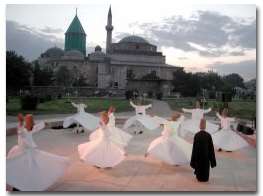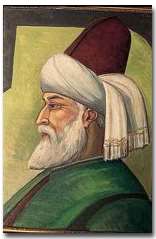Mevlânâ’nın Hayatı
Mevlâna 30 Eylül 1207 yılında bugün Afganistan sınırları içerisinde yer alan Horasan Ülkesi’nin Belh şehrinde doğmuştur. Mevlâna’nın babası Belh Şehrinin ileri gelenlerinden olup, sağlığında “Bilginlerin Sultânı” ünvanını almış olan Hüseyin Hatibî oğlu Bahâeddin Veled’tir. Annesi ise Belh Emiri Rükneddin’in kızı Mümine Hatun’dur.
Sultânü’I-Ulemâ Bahaeddin Veled, bazı siyasi olaylar ve yaklaşmakta olan Moğol istilası nedeniyle Belh’den ayrılmak zorunda kalmıştır. Sultânü’I-Ulemâ 1212 veya 1213 yılllarında aile fertleri ve yakın dostları ile birlikte Belh’den ayrıldı.
 Sultânü’I-Ulemâ’nın ilk durağı Nişâbur olmuştur. Nişâbur şehrinde tanınmış mutasavvıf Ferîdüddin Attar ile de karşılaştılar. Mevlâna burada küçük yaşına rağmen Ferîdüddin Attar’ın ilgisini çekmiş ve takdirlerini kazanmıştır.
Sultânü’I-Ulemâ’nın ilk durağı Nişâbur olmuştur. Nişâbur şehrinde tanınmış mutasavvıf Ferîdüddin Attar ile de karşılaştılar. Mevlâna burada küçük yaşına rağmen Ferîdüddin Attar’ın ilgisini çekmiş ve takdirlerini kazanmıştır.
Sultânü’I Ulemâ Nişabur’dan Bağdat’a ve daha sonra Kûfe yolu ile Kâ’be’ye hareket etti. Hac farîzasını yerine getirdikten sonra, dönüşte Şam’a uğradı. Şam’dan sonra Malatya, Erzincan, Sivas, Kayseri, Niğde yolu ile Lârende’ye (Karaman) geldiler. Karaman’da Subaşı Emir Mûsâ’nın yaptırdıkları medreseye yerleştiler.
1222 yılında Karaman’a gelen Sultânü’/-Ulemâ ve ailesi burada 7 yıl kaldılar. Mevlâna 1225 yılında Şerefeddin Lala’nın kızı Gevher Hatun ile Karaman’da evlendi. Bu evlilikten Mevlâna’nın Sultan Veled ve Alâeddin Çelebi adlı iki oğlu oldu. Yıllar sonra Gevher Hatun’u kaybeden Mevlâna bir çocuklu dul olan Kerrâ Hatun ile ikinci evliliğini yaptı. Mevlâna’nın bu evlilikten de Muzaffereddin ve Emir Âlim Çelebi adlı iki oğlu ile Melike Hatun adlı bir kızı dünyaya geldi.
Bu yıllarda Anadolunun büyük bir kısmı Selçuklu Devleti’nin egemenliği altında idi. Konya’da bu devletin baş şehri idi. Konya sanat eserleri ile donatılmış, ilim adamları ve sanatkarlarla dolup taşmıştı. Kısaca Selçuklu Devleti en parlak devrini yaşıyordu ve Devletin hükümdarı Alâeddin Keykubâd idi. Alâeddin Keykubâd Sultânü’I-Ulemâ Bahaeddin Veled’i Karaman’dan Konya’ya davet etti ve Konya’ya yerleşmesini istedi.
Bahaeddin Veled Sultanın davetini kabul etti ve Konya’ya 3 Mayıs 1228 yılında ailesi ve dostları ile geldiler. Sultan Alâeddin kendilerini  muhteşem bir törenle karşıladı ve Altunapa (İplikçi) Medresesi’ni ikametlerine tahsis ettiler.
muhteşem bir törenle karşıladı ve Altunapa (İplikçi) Medresesi’ni ikametlerine tahsis ettiler.
Sultânü’l-Ulemâ 12 Ocak 1231 yılında Konya’da vefat etti. Mezar yeri olarak, Selçuklu SarayınınGül Bahçesi seçildi. Halen müze olarak kullanılan Mevlâna Dergâhı’ndaki bugünkü yerine defnolundu.
Sultânü’I-Ulemâ ölünce, talebeleri ve müridleri bu defa Mevlâna’nın çevresinde toplandılar. Mevlâna’yı babasının tek varisi olarak gördüler. Gerçekten de Mevlâna büyük bir ilim ve din bilgini olmuş, İplikçi Medresesi’nde vaazlar veriyordu. Vaazları kendisini dinlemeye gelenlerle dolup taşıyordu.
Mevlâna 15 Kasım 1244 yılında Şems-i Tebrizî ile karşılaştı. Mevlâna Şems’de “mutlak kemâlin varlığını” cemalinde de “Tanrı nurlarını”görmüştü. Ancak beraberlikleri uzun sürmedi. Şems aniden öldü.
Mevlâna Şems’in ölümünden sonra uzun yıllar inzivaya çekildi. Daha sonraki yıllarda Selâhaddin Zerkûbî ve Hüsameddin Çelebi, Şems-i Tebrizî’nin yerini doldurmaya çalıştılar.
Yaşamını “Hamdım, piştim, yandım” sözleri ile özetleyen Mevlâna 17 Aralık 1273 Pazar günü Hakk’ ın rahmetine kavuştu. Mevlâna’nın cenaze namazını Mevlâna’nın vasiyeti üzerine Sadreddin Konevî kıldıracaktı. Ancak Sadreddin Konevî çok sevdiği Mevlâna’yı kaybetmeye dayanamayıp cenazede bayıldı. Bunun üzerine, Mevlâna’nın cenaze namazını Kadı Sıraceddin kıldırdı.
Mevlâna ölüm gününü yeniden doğuş günü olarak kabul ediyordu. O öldüğü zaman sevdiğine yani Allah’ına kavuşacaktı. Onun için Mevlâna ölüm gününe düğün günü veya gelin gecesi manasına gelen “Şeb-i Arûs” diyordu ve dostlarına ölümünün ardından ah-ah, vah-vah edip ağlamayın diyerek vasiyet ediyordu.
Hz. Mevlânâ’nın Vasiyeti:
Size, gizlide ve açıkta Allah’tan korkmayı, az yemeyi, az uyumayı, az konuşmayı, isyan ve günahları terk etmeyi, oruç tutmayı, namaza devam etmeyi, sürekli olarak şehveti terk etmeyi, bütün yaratıklardan gelen cefaya tahammüllü olmayı, aptal ve cahillerle oturmamayı, güzel davranışlı ve olgun kişilerle birlikte bulunmayı vasiyet ediyorum. İnsanların en hayırlısı, insanlara yararı olandır. Sözün en hayırlısı, az ve anlaşılır olanıdır.
“Ölümümüzden sonra mezarımızı yerde aramayınız!
Bizim mezarımız âriflerin gönüllerindedir”
{:}{:en}
Rumi was born on 30 September 1207 in Balkh (Modern-day Balkh Province, Afghanistan). He died on 17 December 1273 in Konya in present day Turkey (then Seljuqids of Rum). He was laid to rest beside his father, and over his remains a splendid shrine was erected. The 13th century Mevlana Mausoleum, with its mosque, dance hall, dervish living quarters, school and tombs of some leaders of the Mevlevi Order, continues to this day to draw pilgrims from all parts of the Muslim and non-Muslim world. Jalal al-Din who is also known as Rumi, was a philosopher and mystic of Islam. His doctrine advocates unlimited tolerance, positive reasoning, goodness, charity and awareness through love. To him and to his disciples all religions are more or less truth. Looking with the same eye on Muslim, Jew and Christian alike, his peaceful and tolerant teaching has appealed to people of all sects and creeds. A hagiographical account of him is described in Shams ud-Din Ahmad Aflaki’s Manaqib ul-Arifin (written between 1318 and 1353). Rumi’s father was Baha ud-Din Walad, a theologian, jurist and a mystic from Wakhsh, who was also known by the followers of Rumi as Sultan al-Ulama or “Sultan of the Scholars”. The popular hagiographer assertions that have claimed the family’s descent from the Caliph Abu Bakr does not hold on closer examination and is rejected by modern scholars.[22][23][24] The claim of maternal descent from the Khwarazmshah for Rumi or his father is also seen as a non-historical hagiographical tradition designed to connect the family with royalty, but this claim is rejected for chronological and historical reasons.[22][23][24] The most complete genealogy offered for the family stretches back to six or seven generations to famous Hanafi Jurists.[22][23][24] We do not learn the name of Baha al-Din’s mother in the sources, but only that he referred to her as “Mama” (Mami)[25] (colloquial Persian for Mother), she was a simple woman and that she lives in 13th century. The mother of Rumi was Mu’mina Khatun. The profession of the family for several generations was that of Islamic preachers of the liberal Hanafi rite and this family tradition was continued by Rumi (see his Fihi Ma Fih and Seven Sermons) and Sultan Walad (see Ma’rif Waladi for examples of his everyday sermons and lectures).

When the Mongols invaded Central Asia sometime between 1215 and 1220, Baha ud-Din Walad, with his whole family and a group of disciples, set out westwards. On the road to Anatolia, Rumi encountered one of the most famous mystic Persian poets, ‘Attar, in the Iranian city of Nishapur, located in the province of Khorasan. ‘Attar immediately recognized Rumi’s spiritual eminence. He saw the father walking ahead of the son and said, “Here comes a sea followed by an ocean.” He gave the boy his Asrarnama, a book about the entanglement of the soul in the material world. This meeting had a deep impact on the eighteen-year-old Rumi and later on became the inspiration for his works.
From Nishapur, Walad and his entourage set out for Baghdad, meeting many of the scholars and Sufis of the city.[26] From there they went to Baghdad, and Hejaz and performed the pilgrimage at Mecca. The migrating caravan then passed through Damascus, Malatya, Erzincan, Sivas, Kayseri and Nigde. They finally settled in Karaman for seven years; Rumi’s mother and brother both died there. In 1225, Rumi married Gowhar Khatun in Karaman. They had two sons: Sultan Walad and Ala-eddin Chalabi. When his wife died, Rumi married again and had a son, Amir Alim Chalabi, and a daughter, Malakeh Khatun.
On 1 May 1228, most likely as a result of the insistent invitation of ‘Ala’ ud-Din Key-Qobad, ruler of Anatolia, Baha’ ud-Din came and finally settled in Konya in Anatolia within the westernmost territories of the Seljuk Sultanate of R�m.
Baha’ ud-Din became the head of a madrassa (religious school) and when he died, Rumi, aged twenty-five, inherited his position as the Islamic molvi. One of Baha’ ud-Din’s students, Sayyed Burhan ud-Din Muhaqqiq Termazi, continued to train Rumi in the Shariah as well as the Tariqa, especially that of of Rumi’s father. For nine years, Rumi practiced Sufism as a disciple of Burhan ud-Din until the latter died in 1240 or 1241. Rumi’s public life then began: he became an Islamic Jurist, issuing fatwas and giving sermons in the mosques of Konya. He also served as a Molvi (Islamic teacher) and taught his adherents in the madrassa.
During this period, Rumi also traveled to Damascus and is said to have spent four years there.
It was his meeting with the dervish Shams-e Tabrizi on 15 November 1244 that completely changed his life. From an accomplished teacher and jurist, Rumi was transformed into an ascetic.
Shams had traveled throughout the Middle East searching and praying for someone who could “endure my company”. A voice said to him, “What will you give in return?” Shams replied, “My head!” The voice then said, “The one you seek is Jalal ud-Din of Konya.” On the night of 5 December 1248, as Rumi and Shams were talking, Shams was called to the back door. He went out, never to be seen again. It is rumored that Shams was murdered with the connivance of Rumi’s son, ‘Ala’ ud-Din; if so, Shams indeed gave his head for the privilege of mystical friendship.[27]
Rumi’s love for, and his bereavement at the death of, Shams found their expression in an outpouring lyric poems, Divan-e Shams-e Tabrizi. He himself went out searching for Shams and journeyed again to Damascus. There, he realized:
Why should I seek? I am the same as
He. His essence speaks through me.
I have been looking for myself![28]
Mawlana had been spontaneously composing ghazals (Persian poems), and these had been collected in the Divan-i Kabir or Diwan Shams Tabrizi. Rumi found another companion in Sala? ud-Din-e Zarkub, a goldsmith. After Salah ud-Din’s death, Rumi’s scribe and favorite student, Hussam-e Chalabi, assumed the role of Rumi’s companion. One day, the two of them were wandering through the Meram vineyards outside Konya when Hussam described to Rumi an idea he had had: “If you were to write a book like the Ilahinama of Sanai or the Mantiq ut-Tayr of ‘Attar, it would become the companion of many troubadours. They would fill their hearts from your work and compose music to accompany it.” Rumi smiled and took out a piece of paper on which were written the opening eighteen lines of his Masnavi, beginning with:
Listen to the reed and the tale it tells,
How it sings of separation..
Hussam implored Rumi to write more. Rumi spent the next twelve years of his life in Anatolia dictating the six volumes of this masterwork, the Masnavi, to Hussam.
In December 1273, Rumi fell ill; he predicted his own death and composed the well-known ghazal, which begins with the verse:
How doest thou know what sort of king I have within me as companion?
Do not cast thy glance upon my golden face, for I have iron legs.[30]
Rumi died on 17 December 1273 in Konya; his body was interred beside that of his father, and a splendid shrine, the Ye�il T�rbe (Green Tomb, ??? ???????; today the Mevlana Museum), was erected over his place of burial. His epitaph reads:
When we are dead, seek not our tomb in the earth, but find it in the hearts of men.
Source: Wikipedia
{:}
